

02/2005
A new agenda for Capitol Hill as the AIA Grassroots Leadership and Legislative Conference kicks off
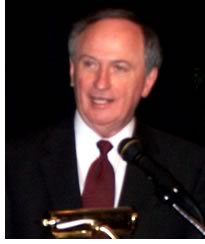
“In the next four days, we’re going to be hearing a lot about community,” said AIA Executive Vice President/CEO Norman L. Koonce, FAIA, as he welcomed nearly 800 AIA officers and component executives to the opening session of the 2005 Grassroots Leadership and Legislative Conference Wednesday afternoon, February 9, in Washington, D.C. “Community, along with Advocacy, Knowledge, and Value, is a focus, a priority, a goal. Communities are interdependent and mutually supportive. They share core values. Their strength is in the number of shoulders that are put to the wheel.”
Koonce noted that a good example of community is this year’s Grassroots Committee, headed by AIA President-elect and Grassroots Chair Kate Schwennsen, FAIA, which truly pulled together as they refashioned the conference agenda to meet needs expressed by last year’s attendees. For instance, the executive vice president explained, the traditional Advocacy Day for this year has been expanded to two days to allow attendees to digest information about the AIA’s new legislative priorities and better interact with members of a new Congress. Koonce then introduced AIA President Douglas L Steidl, FAIA, calling him part of “the small elite company of leaders who have made a positive difference that has been truly inspirational.”
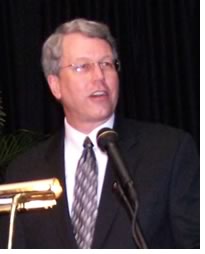 Doing the right thing
Doing the right thing
Steidl talked first of what Grassroots means to him, including the commitment
to do the right thing. “The commitment to make the profession
and your community better is what identifies each of you as a force
of life,” he said. Steidl used as an example the multi-pronged,
ongoing response of the AIA to the tsunami disaster earlier this year—led
at the national level by AIA Chief Operating Officer Jim Dinegar and
Managing Director of the AIA Center for Communities by Design David
Downey, Assoc. AIA—and called for applause for this effort.
This relief effort is also compelling because it reflects the values of the AIA’s strategic plan and newly revised Public Policies, which “focus squarely on core values—what we believe, what we cherish, and what we’re willing to stand for,” Steidl explained. “Our public policies spell out our shared values in three ways: through the architect, through practice, and through the ways in which we engage the world.”
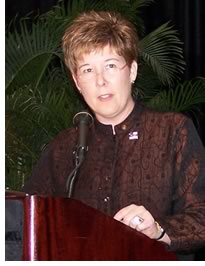 Clear messages in the strategic plan and legislative agenda
Clear messages in the strategic plan and legislative agenda
Steidl in turn introduced Schwennsen, who reminded the attendees that
the AIA’s strategic plan, which is organized by four strategies:
advocacy, community, knowledge, and value, is easy to read and understand. “Deliberately
so, because the hope is that state and local components, as well as
the knowledge communities, will use this plan as a template to develop
their own strategic plans,” she said. “That way we can
all be pulling together.”
With the AIA at all levels speaking with one voice, Schwennsen noted that the obvious question is: “What precisely is the AIA advocating this year? What is the message you and I will be carrying tomorrow to the new Congress?” Though a well-ordered and inclusive process, including a number of surveys of the membership, Schwennsen explained, the legislative agenda this year has four “asks”: affordable housing, renewable energy, brownfields development, and legislation to authorize a transportation/community-enhancement study.
“The lesson here is threefold,” Schwennsen concluded. “Member input in developing a credible AIA advocacy agenda is essential; member understanding of that agenda, as a result of clear and consistent communication, is vital; and member involvement in supporting that agenda is critical for its success.”
 AIA’s new approach to the Hill
AIA’s new approach to the Hill
Schwennsen then introduced AIA Team Vice President for Government Advocacy
Ron Faucheux, Esq., PhD, who, with AIA Lobbyist Tom Wolfe, Esq., introduced
this year’s
legislative agenda. Read about the
AIA’s legislative priorities.
Faucheux spoke about the yearlong effort by members and national staff to revamp the AIA’s legislative agenda and approach to lobbying. “We have developed an extensive federal issues agenda with values that flow directly from the AIA Public Policies,” he explained. “It will help members of Congress know where we stand, both in terms of getting their help with specific initiatives as well as knowing the ‘big picture’ of policy goals we are supporting.”
Faucheux detailed the step-by-step talking points that AIA members should use when talking to members of Congress. For instance, he said that the people on the Hill need to know that the AIA is building a stronger, new grassroots organization and mobilizing our 75,000 members and the 281,000 people who work for architecture firms, and that architects are community builders. “Politicians will want to collaborate with architects publicly, because independent research shows that 83 percent of the public looks favorably upon architects; only 4 percent regard them unfavorably.” Faucheux said. “As a profession, only teachers had a higher rating.”
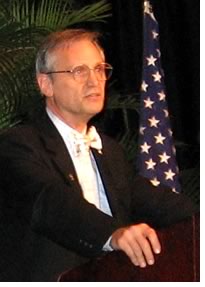 Livable communities and brownfields mitigation
Livable communities and brownfields mitigation
Fresh from a vote on the Hill, Congressmen Earl Blumenauer (D-Ore.) and
Michael Turner (R-Ohio) addressed Grassroots attendees on the importance
of making their voices heard in Congress.
Blumenauer, introduced as “Capitol Hill’s leading voice for livable communities,” told the architects that “you are uniquely positioned, and—I would say—have an obligation to make the case for livable communities.” He explained that the bipartisanship of the livable communities issue presents architects with a great opportunity to gain support in Congress “if you can make the connection. Not only would you be better professionally—the world would be better. It’s the ultimate win-win situation.”
The Congressman also urged architects to devote their legislative efforts to reauthorization of the Transportation Equity Act (TEA-21) Bill and the “greening of the military. The Department of Defense, the largest creator of Superfund sites, needs you to help them create their future.”
“I urge you to be here thinking expansively,” Blumenauer concluded. “You have the skills and the ways to put the pieces together cost-effectively.”
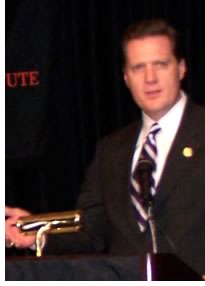 Turner, who had served as mayor of the City of Dayton for eight years,
brought a unique perspective of livable communities as he talked to the
group about the importance of mitigating brownfield sites. “We
are abandoning factories—sometimes right in our neighborhoods,”
said the co-chair of the U.S. Conference of Mayors’ Brownfield
Task Force. “We need to look at ways of taking these sites and
returning them to the communities.”
Turner, who had served as mayor of the City of Dayton for eight years,
brought a unique perspective of livable communities as he talked to the
group about the importance of mitigating brownfield sites. “We
are abandoning factories—sometimes right in our neighborhoods,”
said the co-chair of the U.S. Conference of Mayors’ Brownfield
Task Force. “We need to look at ways of taking these sites and
returning them to the communities.”
Turner explained that the cost of cleaning up brownfield sites to the point of usability—with 500,000 to a million of them in the U.S.—is prohibitive. The brownfield bill, which is now before Congress and for which Turner is a sponsor, offers a tax credit to be allocated by the states for funds to clean up contaminated sites in disadvantaged neighborhoods. This money would apply to 50 percent of the environmental remediation of the site and 100 percent of the total demolition cost of the building if any part of the building needs to be demolished. In conclusion, Turner wished the architects good luck in their legislative endeavors.
The evening’s events wrapped up with a welcome from Frank Musica, Assoc. AIA, head of risk-management publications for Victor O. Schinnerer & Company Inc. and a 22-year Grassroots veteran, who invited attendees to a Schinnerer-sponsored reception immediately following.
Copyright 2005 The American Institute of Architects.
All rights reserved. Home Page ![]()
![]()
 |
||
Stay tuned for next week’s AIArchitect, which will report on how our members fared on the Hill. For more information, visit Government Advocacy on the AIA Web
site.
|
||